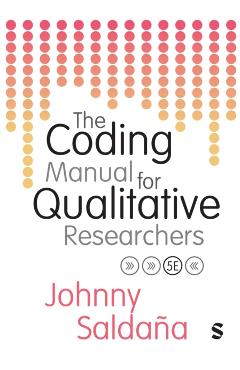The Coding Manual for Qualitative Researchers - Johnny Saldana

Detalii The Coding Manual for Qualitative
libris.ro
279.27 Lei
349.09 Lei
Social Science
Johnny Saldana
The Coding Manual for Qualitative - Disponibil la libris.ro
Pe YEO găsești The Coding Manual for Qualitative de la Johnny Saldana, în categoria Social Science.
Indiferent de nevoile tale, The Coding Manual for Qualitative Researchers - Johnny Saldana din categoria Social Science îți poate aduce un echilibru perfect între calitate și preț, cu avantaje practice și moderne.
Preț: 279.27 Lei
Caracteristicile produsului The Coding Manual for Qualitative
- Brand: Johnny Saldana
- Categoria: Social Science
- Magazin: libris.ro
- Ultima actualizare: 15-12-2024 01:42:32
Comandă The Coding Manual for Qualitative Online, Simplu și Rapid
Prin intermediul platformei YEO, poți comanda The Coding Manual for Qualitative de la libris.ro rapid și în siguranță. Bucură-te de o experiență de cumpărături online optimizată și descoperă cele mai bune oferte actualizate constant.
Descriere magazin:
Especially useful for utilization in higher education, administrative research, general development, the arts, social sciences, nursing, business, and health care. That may seem like a vast application, but both students and professionals will appreciate the clarity and the emblematic mentorship this book provides. - American Journal of Qualitative Research This invaluable manual from world-renowned expert Johnny Saldaña illuminates the process of qualitative coding and provides clear, insightful guidance for qualitative researchers at all levels. The fourth edition includes a range of updates that build upon the huge success of the previous editions: A structural reformat has increased accesibility; the 3 sections from the previous edition are now spread over 15 chapters for easier sectional reference There are two new first cycle coding methods join the 33 others in the collection: Metaphor Coding and Themeing the Data: Categorically Includes a brand new companion website with links to SAGE journal articles, sample transcripts, links to CAQDAS sites, student exercises, links to video and digital content Analytic software screenshots and academic references have been updated, alongside several new figures added throughout the manual It remains the only book that looks specifically at coding qualitative data, as a core but often neglected skill that researchers and students alike need to effectively make sense of their data and to identify patterns, before they can analyse the material. Saldana presents a range of coding options with advantages and disadvantages to help researchers to choose the most appropriate approach for their project, reinforcing their perspective with real world examples, used to show step-by-step processes and to demonstrate important skills

Produse asemănătoare

The Coding Manual for Qualitative Researchers. 5 Revised edition, Paperback/Johnny Saldana
![]() elefant.ro
elefant.ro
Actualizat in 26/10/2025
295.99 Lei
Produse marca Johnny Saldana

Coding Manual for Qualitative Researchers - Johnny Saldana
![]() libris.ro
libris.ro
Actualizat in 28/10/2025
330.3 Lei

The Coding Manual for Qualitative Researchers - Johnny Saldana
![]() libris.ro
libris.ro
Actualizat in 15/12/2024
279.27 Lei